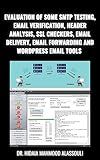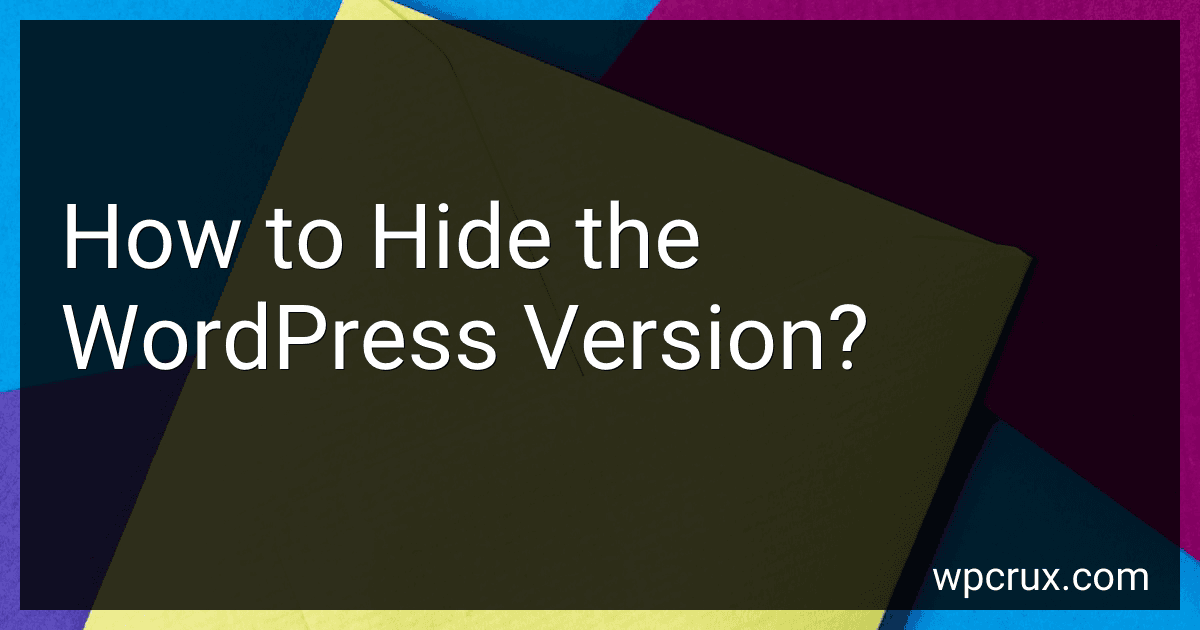Best WordPress Security Tools to Buy in October 2025

Evaluation of Some SMTP Testing, Email Verification, Header Analysis, SSL Checkers, Email Delivery, Email Forwarding and WordPress Email Tools



WordPress for Beginners 2019: A Visual Step-by-Step Guide to Mastering WordPress (Webmaster Series)



WordPress GUIDE COMPLET Simple et Efficace: English Edition-Complete Guide (DigitalMarket)


To hide the WordPress version, you can follow these steps:
- Open your WordPress dashboard.
- Go to the "Appearance" tab and select "Editor."
- On the right-hand side, you will see a list of template files. Look for a file named "functions.php" or "theme functions."
- Click on that file to open it.
- Scroll down to the end of the file or search for the line that starts with "?>" to make sure you are at the end.
- Add the following line of code just before the "?>":
function remove_version() { return ''; } add_filter('the_generator', 'remove_version');
- Save the changes by clicking on the "Update File" button.
- Now, when someone inspects the source code of your website or uses tools to check the WordPress version, they won't be able to see the version number.
By hiding the WordPress version, you can enhance the security of your website by making it less vulnerable to potential attacks.
How can I check the current WordPress version on a website?
There are a few ways to check the current WordPress version on a website:
- Admin dashboard: If you have access to the WordPress admin dashboard, you can find the version number at the bottom of most admin pages. Scroll down to the bottom, and you'll see the version number in the bottom right corner.
- Viewing the page source: Right-click on any page of the website and select "View Page Source" or "Inspect Element" (depending on your browser). In the page source, search for "wp-content" or "wp-includes" folders. Within these folders, you should find a file named "version.php" or similar, which will indicate the WordPress version.
- Online tools: Several online tools allow you to check the WordPress version by entering the website URL. Examples include "What WordPress Theme Is That?" (https://whatwpthemeisthat.com/) and "WPSCAN" (https://wpscan.com/). These tools scan the website and display details, including the WordPress version.
Note that it's always recommended to keep WordPress and its plugins/themes updated to the latest version for security and performance reasons.
What steps can I take to protect my WordPress website from version-specific attacks?
To protect your WordPress website from version-specific attacks, you can take the following steps:
- Keep your WordPress version updated: Regularly update to the latest version of WordPress to ensure you have the latest security patches and bug fixes. WordPress releases new versions specifically to address vulnerabilities, so staying up to date is crucial.
- Update plugins and themes: Similarly, keep all your plugins and themes updated to their latest versions. Vulnerabilities often exist in outdated plugins and themes, so updating them regularly helps protect against attacks.
- Remove unused plugins and themes: Delete any unused plugins and themes from your WordPress installation. Even if they are not active, they can still pose a security risk if they contain vulnerabilities that can be exploited.
- Use only trusted themes and plugins: Download themes and plugins from reputable sources like the WordPress.org repository or trusted developers. Check the ratings, reviews, and update frequency to ensure they are actively maintained and secure.
- Use strong, unique passwords: Secure your WordPress admin account with strong, complex passwords that include a combination of upper and lower case letters, numbers, and special characters. Avoid using predictable passwords, such as "password" or "admin".
- Implement two-factor authentication (2FA): Add an extra layer of security to your WordPress login by enabling 2FA. This requires users to provide a second form of authentication, such as a unique code sent to their phone, in addition to their regular password.
- Set up a website firewall: Consider using a website firewall that can detect and block suspicious traffic, malicious requests, and known exploits. Web application firewalls (WAFs) can help protect your site from various types of attacks, including version-specific ones.
- Regularly backup your website: Perform regular backups of your WordPress website, including the database and files. This way, if an attack occurs, you can restore your site to a previous, secure version without losing all your data.
- Monitor security alerts: Stay informed about the latest security vulnerabilities and threats affecting WordPress. Subscribe to security newsletters, follow WordPress security blogs, and set up alerts to receive notifications about new vulnerabilities so you can take action promptly.
- Consider a security plugin: Install a reputable security plugin that provides additional security measures, such as malware scanning, brute force attack prevention, and login lockdown features. Popular security plugins include Sucuri, Wordfence, and iThemes Security.
By following these steps, you can significantly enhance the security of your WordPress website and minimize the risk of version-specific attacks.
How does hiding the WordPress version enhance website security?
Hiding the WordPress version enhances website security by making it more difficult for potential attackers to target vulnerabilities based on the known version number.
Here's how hiding the WordPress version can contribute to website security:
- Limited exposure: By hiding the WordPress version, website owners minimize the exposure of any potential vulnerabilities that might exist in that specific version. Hackers often target vulnerabilities in outdated or popular WordPress versions, so hiding the version can protect against automated attacks searching for specific version vulnerabilities.
- Protection against exploitation: If an attacker knows the WordPress version of a website, it becomes easier for them to exploit known vulnerabilities or security issues specific to that version. By hiding the version, it adds an extra layer of difficulty for attackers trying to gain unauthorized access to the website.
- Delayed patching: Sometimes, website owners delay updating to the latest WordPress version due to compatibility or other reasons. By hiding the version number, even if a website is running an outdated version, it becomes more challenging for attackers to identify the specific version and known vulnerabilities associated with it.
- Security through obscurity: Although not a foolproof security measure on its own, hiding the WordPress version adds to the concept of security through obscurity. It obscures potential vulnerabilities and makes it harder for attackers to find an entry point into the website. It's important to note that relying solely on security through obscurity is not recommended, and it should be combined with other security practices.
While hiding the WordPress version can contribute to website security, it's crucial to implement other security measures such as using strong passwords, keeping themes/plugins updated, regular backups, and using security plugins to ensure a robust security posture for the website.
Can I hide the WordPress version using a content delivery network (CDN)?
No, the version of WordPress cannot be hidden using a content delivery network (CDN) alone. The version information is typically included in the HTML source code generated by WordPress itself and is not affected by the CDN. If you want to hide the WordPress version, you would need to modify the code or use additional security features like plugins or custom coding.
Which WordPress plugins can help in hiding the version number?
There are several WordPress plugins that can help in hiding the version number. Some popular options include:
- Hide My WP: This plugin not only hides the WordPress version, but also changes the default plugin and theme paths to make it difficult for potential attackers to identify the CMS being used.
- WP Hide & Security Enhancer: This plugin allows you to easily remove or change the WordPress version number from the HTML output and also provides additional security enhancements.
- Remove Generator Meta Tag: This simple plugin specifically targets the WordPress generator meta tag that displays the version number in the HTML source code and removes it.
- SecuPress: Apart from offering various security features, this plugin allows you to hide the WordPress version as well as change the WP-admin and WP-login URLs.
- All In One WP Security & Firewall: This comprehensive security plugin provides an option to hide the WordPress version number and offers various other security measures.
Remember to always keep your WordPress installation and plugins up to date to ensure maximum security, regardless of whether you choose to hide the version number or not.
How can I customize the "generator" meta tag to hide the WordPress version?
To hide the WordPress version from the "generator" meta tag, you can use one of the following methods:
- Use a Plugin: Install and activate a plugin like "Hide Generator" or "WP Hide & Security Enhancer". Once activated, these plugins will automatically remove or modify the "generator" meta tag to hide the WordPress version.
- Theme Functions.php: Access your WordPress theme files via appearance editor or FTP. Open the "functions.php" file of your theme. Add the following code at the end of the file: function remove_generator_tag() { return ''; } add_filter( 'the_generator', 'remove_generator_tag' ); Save the changes and upload the modified file back to your server. This code will remove the generator tag entirely, hiding the WordPress version from the meta tag.
- Custom Function plugin: If you don't want to modify the theme files directly, you can create a custom plugin. Create a new PHP file, e.g., "custom-functions.php", and place the following code in it: "Add New". Click on the "Upload Plugin" button, select the ZIP file, and click "Install Now". Finally, activate the "Custom Functions" plugin.
After applying any of these methods, the "generator" meta tag will be modified or removed, effectively hiding the WordPress version.
